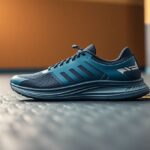
Delve into the revolutionary advancements in running footwear technology that have significantly reshaped the realm of performance enhancement for endurance athletes. This exploration reveals how modern innovations are driving the future of athletic performance.
The realm of performance optimisation in endurance running has undergone a remarkable transformation due to advanced footwear technology, presenting you with unparalleled opportunities to elevate your athletic capabilities. Here, you will learn how state-of-the-art shoe designs can significantly decrease your metabolic expenditure while enhancing your running economy. By incorporating carbon fibre plates and pioneering midsole materials, these advanced shoes offer exceptional energy return mechanisms that can potentially reduce your oxygen consumption by as much as 4%. Regardless of whether you are a seasoned professional or an enthusiastic amateur, grasping these biomechanical innovations enables you to make educated choices regarding your running gear and enhance your racing performance.
 Continue reading to gain deeper insights into the mechanics of running footwear designed to enhance athletic performance:
Continue reading to gain deeper insights into the mechanics of running footwear designed to enhance athletic performance:
Unpacking Energy Return Mechanisms in Next-Generation Running Shoes
The technology behind advanced running shoes leverages intricate biomechanical principles to enhance energy transfer during dynamic movement. Innovative design features work in harmony to minimise metabolic expenditure, establishing a sophisticated system that maximises running efficiency through intentional material science and geometric configurations. By concentrating on energy return mechanisms, these shoes provide runners with a profound edge in both performance and stamina, facilitating longer runs with diminished fatigue.
Investigating the Curvature Dynamics of Carbon Fibre Plates
Carbon fibre plates utilise precise geometric engineering to effectively redirect kinetic energy during the act of running. Optimal curvature angles ranging from 12° to 15° enable maximum energy storage and return, with finite element modelling indicating an impressive energy return efficiency of up to 93% in prototype designs. These expertly engineered plates form a spring-like mechanism that lessens muscular exertion during toe-off phases, empowering runners to conserve energy over extended distances, thereby enhancing overall endurance and performance.
Contrasting TPU and EVA in Midsole Innovations for Enhanced Performance
Material selection plays a pivotal role in determining shoe performance, with thermoplastic polyurethane (TPU) emerging as a leading midsole technology. Comparative studies highlight TPU’s substantial advantages in both energy return and impact absorption, granting runners improved biomechanical efficiency across various running conditions. The decision between TPU and EVA foam is essential for athletes aiming to optimise their performance while minimising the risk of injuries during training and competitive events.
| Energy Return | 18% higher in TPU |
| Oxygen Consumption Reduction | 2.4% lower with TPU |
A closer examination of midsole materials reveals detailed performance characteristics that are vital for runners. TPU has shown superior resilience when compared to traditional EVA foam, maintaining consistent mechanical properties over thousands of compression cycles. Runners benefit from more reliable energy return, decreased fatigue, and improved long-distance performance due to advancements in material science, which can greatly influence their overall training outcomes and competitive results.
| Impact Absorption | TPU absorbs 37% more force |
| Rebound Elasticity | 89% maintained across 50,000 cycles |
 Explore further as we delve into the impact of advanced footwear technology on metabolic efficiency:
Explore further as we delve into the impact of advanced footwear technology on metabolic efficiency:
Evaluating Metabolic Efficiency: Identifying Who Benefits Most from Advanced Footwear
The advantages of advanced footwear technology do not apply equally to all runners. Metabolic efficiency gains differ considerably among various demographic groups, with factors such as gender, age, and individual biomechanics playing vital roles in performance improvements. Researchers have identified nuanced patterns of metabolic response, revealing that the benefits of these super shoes extend beyond mere performance metrics, encompassing complex physiological adaptations unique to each runner’s individual biomechanical profile.
Investigating Gender-Specific Enhancements in Running Performance
Female runners demonstrate a 3.2% improvement in metabolic power as opposed to 4.2% in male runners, indicating intricate neuromuscular adaptations at play. Pelvic kinematics data unveils a 14% greater reduction in hip adduction angle in females using advanced footwear, potentially elucidating the subtle differences in metabolic gains observed between genders. Acknowledging these differences can assist in tailoring training and footwear selections to maximise performance advantages for each gender.
Understanding Age-Related Benefits and Their Influence on Endurance Performance
Masters athletes aged 40 and above showcase a 2.8% greater reduction in oxygen cost when employing super shoes, likely compensating for declines in tendon elasticity. Tibial loading analysis reveals a 12% cumulative stress reduction per kilometre in older runners, suggesting potential benefits regarding injury prevention and performance maintenance. These findings underscore the significance of advanced footwear technology in prolonging the competitive lifespan of older athletes.
The benefits of advanced footwear technology related to age extend significantly beyond simple performance metrics. Biomechanical studies indicate that older runners experience more pronounced adaptations due to compensatory mechanisms. Reduced tendon stiffness and altered muscle recruitment patterns interact with shoe technology to create a unique profile of performance enhancement. Specifically, the energy return mechanism of the carbon plate seems to counteract age-related biomechanical inefficiencies, potentially prolonging competitive running careers by alleviating the physiological limitations typically associated with older athletes.
Continue reading to explore the implications of advanced footwear technology on injury risks:
Investigating the Relationship Between Running Footwear and Injury Risk
Advanced footwear technology presents intricate biomechanical interactions that necessitate a detailed examination of potential injury risks. Runners must carefully balance the benefits of performance enhancement against physiological adaptations. Longitudinal studies highlight subtle yet significant alterations in muscular recruitment patterns, joint loading, and proprioceptive feedback when transitioning to high-performance running shoes, emphasising the necessity for a balanced approach to both training and recovery.
Injury Analysis: The Price of Enhanced Performance
Biomechanical research indicates a 9% increase in Achilles tendon strain rates among users of super shoes during high-intensity training. Plantar pressure mapping demonstrates a 22% increase in forefoot loading compared to traditional trainers, especially on challenging terrain such as downhill running. These findings suggest that while metabolic efficiency may improve, runners need to implement targeted strength and adaptation protocols to mitigate potential injury risks and ensure long-term athletic health.
Modifying Training Protocols for Optimal Gait Adaptations
Your biomechanical response to the adoption of advanced footwear necessitates strategic adjustments in your training regimen. Gait retraining is essential to optimise the unique energy return mechanisms of carbon-plated shoes. Runners should prioritise developing neuromuscular patterns that align with the shoe’s biomechanical design, which can help reduce injury risk while maximising performance benefits.
Comprehensive gait adaptation strategies encompass multifaceted approaches to effectively integrate advanced footwear technology. Biomechanical analysis indicates that runners typically require 6-8 weeks of progressive training to fully adapt to the unique mechanical properties of super shoes. This adaptation phase involves targeted eccentric strengthening protocols, adjusted interval training techniques, and meticulous monitoring of lower limb biomechanics. Professional athletes and dedicated runners will benefit from periodic 3D gait analysis to track subtle variations in movement patterns, thus ensuring the optimal integration of advanced footwear technology with their individual biomechanical characteristics.
 Explore the promising future of footwear technology and its implications for runners:
Explore the promising future of footwear technology and its implications for runners:
Investigating Future Innovations in Running Footwear Technology
Emerging technologies are on the verge of transforming the design of running shoes, pushing the limits of biomechanical efficiency and performance optimisation. Cutting-edge research is focusing on personalised solutions that adapt to individual biomechanics, utilising advanced materials, computational modelling, and integrated sensor technologies to develop a new generation of intelligent footwear tailored for elite athletes.
Revolutionising Footwear Design Through 3D Printed Midsoles
Lattice structure optimisation algorithms now facilitate precise regional stiffness variations that correspond with individual foot pressure maps. Prototype testing has shown a 5.1% additional metabolic saving compared to standardised models, with computational design enabling unprecedented customisation of midsole geometries to maximise energy return and minimise biomechanical stress. This forward-thinking approach ensures that each runner can achieve optimal performance tailored to their unique physical attributes.
Integrating Smart Technology for Enhanced Performance Monitoring
Innovative sensor technologies are evolving to transform running shoes into sophisticated performance tracking devices. Real-time ground reaction force feedback systems can lower oxygen costs by 1.9% through micro-adjustments in cadence, providing runners with immediate biomechanical insights during both training and competitive events. These advancements are essential for athletes aiming to refine their technique and enhance performance metrics.
The integration of advanced sensor technology signifies a groundbreaking shift in performance monitoring capabilities. Multi-axis accelerometers, pressure-sensitive matrices, and embedded microprocessors now capture intricate biomechanical data with unparalleled precision. These intelligent systems analyse gait mechanics, impact forces, and energy expenditure in real-time, delivering runners detailed insights into their movement patterns. Machine learning algorithms now have the ability to foresee potential injury risks, optimise training loads, and recommend personalised technique adjustments based on extensive movement analysis, thus converting running shoes from passive equipment into active performance optimisation tools.
Finally, gain a comprehensive understanding of the transformative landscape of advanced footwear technology in endurance running:
Embracing the Future of Advanced Footwear Technology in Endurance Running
In summary, you have explored the transformative landscape of advanced footwear technology within the context of endurance running. Your comprehension now includes how innovative design elements such as carbon plates and high-performance midsole materials can substantially lower metabolic costs while enhancing running efficiency. By leveraging scientific knowledge, you can appreciate that these shoes provide more than just marginal gains—they signify a paradigm shift in athletic performance. Your investment in such technology could potentially lead to improved running economy, decreased energy expenditure, and optimised biomechanical responses across a diverse range of athletic demographics.
The Article Biomechanical Efficiency of Advanced Footwear Technology: Metabolic Cost Reduction and Performance Enhancement in Endurance Running appeared first on My Shoes Finder.
The Article Biomechanical Efficiency in Advanced Footwear for Runners Was Found On https://limitsofstrategy.com








It’s fascinating to see how advancements in footwear technology have transformed endurance running. As someone who has dabbled in both sprinting and long-distance events, I’ve experienced firsthand how crucial the right shoe can be for performance and comfort. The incorporation of carbon fibre plates is particularly intriguing, as they not only enhance energy return but also seem to encourage a more efficient running form.
It’s interesting to hear about your experiences in both sprinting and long-distance running. Those insights about shoe technology really highlight how tailored footwear has become for different styles of running. The carbon fiber plate implementation is definitely a game changer; it’s remarkable how something that seems so technical can bring about such a palpable difference in performance.